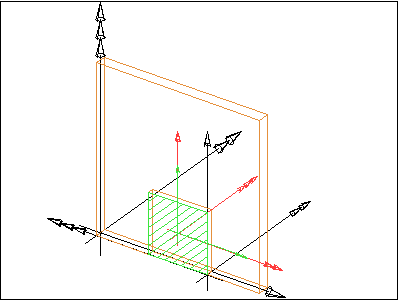
IfcOpeningElement
Definition from IAI: The opening element
stands for opening, recess or chase, all reflecting voids. It
represents a void within any element that has physical manifestation.
Openings must be handled by all sectors and disciplines in AEC/FM
industry, therefore the interoperability for opening elements is
provided at this high level.
There are two different types of opening elements:
- an opening, where the thickness of the opening is greater
or equal to the thickness of the element;
- a recess or niche, where the thickness of the recess is
smaller than the thickness of the element.
The inherited attribute ObjectType should
be used to capture the differences,
- the attribute is set to 'Opening' for an
opening or
- the attribute is set to 'Recess' for a
recess or niche.
- If the value for ObjectType is omitted,
opening is assumed.
An IfcOpeningElement has to be inserted
into a building element (all subtypes of IfcBuildingElement)
by using the IfcRelVoidsElement relationship. It is
also directly linked to the spatial structure of the project (and here
normally to the IfcBuildingStorey) by using the IfcRelContainedInSpatialStructure
relationship.
HISTORY
New entity in IFC Release 1.0
IFC2x
PLATFORM CHANGE: The intermediate ABSTRACT supertypes IfcFeatureElement
and IfcFeatureSubtraction have been added between IfcElement
and IfcOpeningElement with upward compatibility.
Property Set Use Definition:
The property sets relating to the IfcOpeningElement
are defined by the IfcPropertySet and attached by
the IfcRelDefinesByProperties relationship. It is
accessible by the inverse IsDefinedBy relationship.
The following property set definitions specific to the IfcOpeningElement
are part of this IFC release:
Quantity Use Definition:
The quantities relating to the IfcOpeningElement
are defined by the IfcElementQuantity and attached
by the IfcRelDefinesByProperties. The following
quantities are foreseen, but will be subjected to the local standard of
measurement:
| Name |
Description |
Value Type |
| OpeningArea |
Area of the opening as viewed by an elevation view
(for wall openings) or as viewed by a ground floor view (for floor
openings). The exact definition and calculation rules depend on the
method of measurement used. |
IfcAreaQuantity |
Geometry Use Definitions
The geometric representation of IfcOpeningElement
is given by the IfcProductDefinitionShape and IfcLocalPlacement
allowing multiple geometric representations.
Local Placement
The local placement for IfcOpeningElement
is defined in its supertype IfcProduct. It is
defined by the IfcLocalPlacement, which defines the
local coordinate system that is referenced by all geometric
representations.
- The PlacementRelTo relationship of IfcLocalPlacement
should point to the local placement of the same element, which is
voided by the opening, i.e. referred to by VoidsElement.RelatingBuildingElement.
Geometric Representation
Currently, the use of 'SweptSolid', 'Brep', and
'MappedRepresentation' representation is supported.
Swept Solid Representation, Horizontal Extrusion
The standard geometric representation of IfcOpeningElement
is defined using the swept area solid geometry. The attribute RepresentationType
of IfcShapeRepresentation should have the value
'SweptSolid'. The following additional constraints apply to the swept
solid representation:
- Solid: IfcExtrudedAreaSolid
is required.
- Profile: IfcRectangleProfileDef,
IfcCircleProfileDef and IfcArbitraryClosedProfileDef
shall be supported.
- Extrusion: The profile shall be extruded
horizontally (i.e. perpendicular to the extrusion direction of the
voided element), e.g. for wall openings, or vertically (i.e. in the
extrusion direction of the voided element), e.g., for floor openings.
Special agreement for defining openings in round
building elements, e.g., in round walls. The opening width,
in case of a rectangular opening equal with the IfcRectangleProfileDef.XDim,
is defined as the straight line distance between two parallel jambs. If
the jambs are defined radial (to the center of the arc used to define
the round wall) then the opening width is defined to be the outer arc
length.
NOTE: In case of non-parallel
jambs, the geometry expression is not an extruded area solid, it has to
be represented using other types of representations.
EXAMPLE for openings
 |
The following interpretation of dimension parameter
applies for rectangular openings:
- IfcRectangleProfileDef.YDim interpreted as opening
width
- IfcRectangleProfileDef.XDim interpreted as opening
height
NOTE: Rectangles are now defined centric, the placement
location has to be set:
- IfcCartesianPoint(XDim/2,YDim/2)
|
EXAMPLE for recesses
 |
The following interpretation of dimension parameter
applies for rectangular recess:
- IfcRectangleProfileDef.YDim
interpreted as recess width
- IfcRectangleProfileDef.XDim
interpreted as recess height
- IfcExtrudedAreaSolid.Depth is
interpreted as recess depth
NOTE: Rectangles are now defined centric, the placement
location has to be set:
- IfcCartesianPoint(XDim/2,YDim/2)
NOTE: The local placement directions for the IfcOpeningRecess
are only given as an example, other directions are valid as well.
|
NOTE In case of recesses also
profiles of type IfcArbitraryProfileDefWithVoid
shall be supported as a 'SweptSolid' representation.
Swept Solid Representation, Vertical Extrusion
The advanced geometric representation of IfcOpeningElement
is defined using the swept area solid geometry, however the extrusion
direction may be vertical, i.e. in case of a wall opening, the
extrusion would be in the direction of the wall height. The attribute RepresentationType
of IfcShapeRepresentation should have the value
'SweptSolid'. The following additional constraints apply to the swept
solid representation:
- Solid: IfcExtrudedAreaSolid
is required.
- Profile: IfcRectangleProfileDef,
IfcCircleProfileDef and IfcArbitraryClosedProfileDef
shall be supported.
- Extrusion: The profile shall be extruded
vertically, i.e. for wall openings along the extrusion direction of the
voided element.
Vertical extrusions shall be used when an opening or recess has a non
rectangular foot print geometry that does not change along the height
of the opening or recess.
Brep Representation
The general b-rep geometric representation of IfcOpeningElement
is defined using the Brep geometry. The Brep representation allows for
the representation of complex element shape. It is ensured by assigning
the value 'Brep' to the RepresentationType
attribute of IfcShapeRepresentation The RepresentationIdentifier
of IfcShapeRepresentation should then have the
value 'Body'.
EXPRESS specification:
Attribute definitions:
| HasFillings
|
:
|
Reference to the Filling Relationship that is used to assign Elements as Fillings for this Opening Element.
The Opening Element can be filled with zero-to-many Elements.
|
Inheritance graph
|
|
| ENTITY IfcOpeningElement;
|
|

